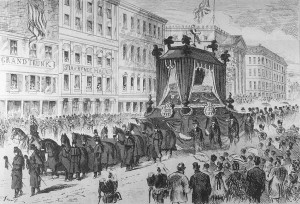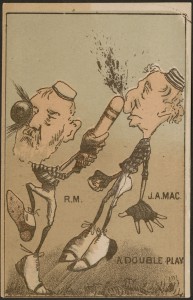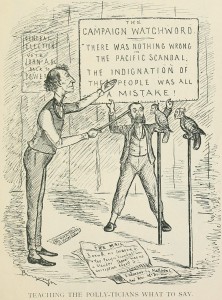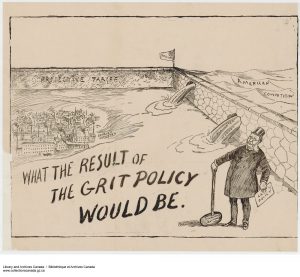4.2 John A. Macdonald’s Canada
The issue that faced John A. Macdonald and his contemporaries at the federal level was the extent to which Ottawa could build a nation on the basis of two founding cultures. (This, of course, was an exercise that completely ignored the presence of Aboriginal cultures except insofar as it endeavoured to subjugate and/or alter them.) For the most part Macdonald’s generation opted to focus on economic bonds rather than cultural bridges. Macdonald’s National Policy may be understood in this context as an articulation of a vision of Canada. The tariff protected Canadian manufacturers and therefore shielded Canada against American economic aggression. The Intercolonial Railway was quickly overshadowed by a railway to the Pacific, which had the same goals. The deployment of a national constabulary and temporary military units in the West affirmed Canadian determination to execute its territorial strategy against American possibilities. In these ways, and in others, the National Policy has been interpreted as an instrument of nationalism as well as economic development. The mixture of technology, science, engineering, and notions of progress on which the railways depended was something that informed public life and became a premise of the new Dominion. As one historian has argued, this was a “philosophy of railways,” a commitment to an instrument of Canadian ambitions that was simultaneously economic, political, nationalistic, and cultural.[1] And it was on this project that Macdonald pinned his career and the success of his party.
As a politician, Macdonald was regarded as “crafty,” a term that was not always offered as praise. Macdonald was unafraid of hard work (he is reckoned to have almost single-handedly drafted the Quebec Resolutions that led to the BNA Act) and his earlier position as an outsider within the Tory Party may have driven him to labour twice as hard to be half as good. He drank heavily and was beset by some of the ill-health that comes with too much alcohol. His wit was sharp and he was often self-effacing. Macdonald’s ability to delay and postpone, and wear out his opponents, earned him the nickname Old Tomorrow. His biographers paint a picture of a man who simultaneously led from the front while demonstrating a preference for serving his caucus rather than having his caucus serve him.
This last point is important because of the extent to which Canadian politics have become characterized by what is sometimes called “presidential prime ministers.” The Canadian system does not provide for the election of a prime minister, only two or more caucuses, one of which (ideally) is large enough to form government. It is implicit in responsible government that the executive (or cabinet) serves at the sufferance of the largest caucus (from which it is drawn), and that the caucus may, if needs be, direct the government to change direction. Macdonald’s career was profoundly shaped by debates about responsible government; building a majority in the House was his specialty and he had been doing so since the 1850s. Dividing Canadian history along the benchmark of 1867 means we sometimes lose sight of the fact that Macdonald spent decades fighting and winning in politics.
Macdonald was effective as a leader in large part because he had strong co-leaders in Quebec whom he treated as partners and confidantes. The first of these, of course, was George-Étienne Cartier (1814-73), without whom it is unlikely that Quebec would have agreed to Confederation. Cartier, too, played the pivotal role in negotiations with Britain regarding the annexation of Rupert’s Land, and he pressed vigorously for the addition of British Columbia. It was Cartier who put the idea of a Pacific railway on the table. Cartier’s death in 1873 produced a great public outpouring of grief, much of it stage-managed but not all: 50,000 to 100,000 spectators lined the route of his funeral procession. Macdonald was stricken and, when he announced Cartier’s passing to the House of Commons he was silenced by his own sobbing.[2]

Hector-Louis Langevin (1826-1906) subsequently took up the task of leading Quebec within the Conservative government, but he had a difficult time of it. The execution of Riel poisoned relations between French-Catholics and the Tory Party. Langevin won re-election in 1887 (despite being called a “hangman”) but few of his Conservative colleagues were so lucky. Macdonald appreciated Langevin’s efforts and skills and made him Minister of Public Works — a fateful decision. Public works played an important role in the building and maintenance of, among other things, bridges and docks, which made it an effective instrument of patronage to loyal supporters of the government. It also placed the minister in the path of temptation. Allegations of corruption with respect to railways in Quebec and British Columbia circled around Langevin. Another potential scandal in Ontario had the potential to end the career of the prime minister as well as Langevin: a dry-dock construction project in Macdonald’s own constituency of Kingston involved public contracts assigned to a man who did not exist. Despite this, Macdonald held on to the bitter end to the ideal of a French-Canadian successor, and it was Langevin he had in mind. This was an indication of the depth of Macdonald’s conviction that the two “founding nations” ought to rule the country together.
Macdonald’s commitment to this perspective was older than the Dominion itself. His close alliance and friendship with Cartier – a rebel of 1837, a Bleu leader 30 years later, and the government’s man in Quebec — was pivotal to the successful inclusion of Quebec in Confederation. Macdonald knew through his work with Cartier that culture mattered. At the same time, Macdonald and his supporters were committed to the view that the northwest would be Canadianized, which for all intents and purposes meant cleared of First Nations and Métis, and remade in the shape of Ontarian, Anglo-Protestant society. The diffusion of Anglo-Canadian values took place in a variety of settings, including the courts and the legal system, the legislatures, and the schools.

No event in his long political career so defined Macdonald’s legacy as the hanging of Riel (see Sections 2.7 and 2.8). As one French-Canadian Tory MP from Montreal said, “Sir John saw the dawn of his political career lit by the glow from the burning parliament buildings in Montreal; its sunset will fade behind the gallows in Regina.”[3] While Ontario’s Orange Lodges were baying for blood — they wanted Riel to hang for the murder of Thomas Scott in 1870 and not necessarily for treason in 1885 — Quebec was incensed by Ottawa’s treatment of the Catholic-French Métis community since the Red River uprising. The failure to create a French/English society in the West, the subsequent marginalization of the Métis population, the heavy-handed performance of centralist federal politicians, and Ottawa’s apparent disregard for the Quebec economy was all read as a long trail of broken promises. The hard-line ultramontanist movement became increasingly active in criticizing francophone Conservatives as serving Ottawa and Macdonald rather than Quebec and the French-Catholic culture. This was paralleled by the growth of nationalist sentiment among the Canadiens.
There was, too, a growing sense in Quebec that industrialization and modernization threatened the rural stability of francophone society. There was a great deal of truth in the fact that industrialism was being imposed on French-Canadians and on the countryside because all but a handful of the industrial elite was anglophone and urban. While the CPR might function in English Canada in the 1880s as a symbol of technological and economic progress, in Quebec it represented for many a diversion of wealth to a francophone-hostile Western periphery and the resultant high unemployment. A consequence of this economic impact was the emigration of Québecois youth to the United States. All of these ingredients were simmering when the Northwest Rebellion of 1885 occurred. Sympathy for the Métis was easy to evoke, but Riel was more complicated: The Catholic clergy recognized their flock in the West but had to be firm in their opposition to Riel’s heretical pronouncements. Once Riel recanted his more idiosyncratic beliefs, the whole of Québecois society seemed on his side. His hanging provoked a mass demonstration in Montreal’s Champ-de-Mars at which Macdonald was burned in effigy.
Thereafter, the fortunes of the Conservative Party in Quebec crashed. With the exception of some seats in Montreal and a few scattered over the countryside, there was by 1887 little left of Cartier’s Bleu-Conservative machine. Indeed, the Conservative Party in Quebec would never fully recover, although it might have were it not for the compounding effects of Borden’s conscription legislation in the Great War.

Macdonald led the government through two parliaments in 1867-73, was pushed out of office on a tide of corruption allegations known as the Pacific Scandal, and returned for four more parliaments from 1878 to his death in 1891. The Macdonald administrations are mostly remembered for the National Policy (see Section 3.3), and it has been argued that the Conservatives — and Alexander Mackenzie’s Liberals from 1873-1878 — could not build a nation based on a culture and so opted for economic unity, but this was a unity that was far from equal. It did, however, create a separate economic order north of the United States. Historians have both praised the tariff policy as the source of Canada’s industrial take-off, and criticized it for suffocating industry in the West and the Maritimes while encouraging Americans to set up their own factories in Canada. These early branch plants were a harbinger of 20th century developments that would see a closer integration of the two nations’ economies, regardless of the tariff. The weight of votes was in the manufacturing hubs of central Canada, something even the Liberals could not ignore forever. By 1896 the Grits abandoned their pro-reciprocity position (at least temporarily) and joined the tariff camp.

Macdonald maintained to the bitter end that the tariff was essential to protecting more than Canadian industry. It protected Canada as a whole. In part this was rhetoric, displayed most clearly in his 1891 campaign which was explicitly nationalistic and pro-tariff, but it was also sincerely believed. There were enough continentalists in the Liberal Party — including its 1880s leader Edward Blake (1833-1912) and his outspoken colleague Goldwin Smith (1823-1910) — to demonstrate that a return to reciprocity or, worse, a common tariff policy with the United States was likely to be the first step toward the end of Canada.
Key Points
- John A. Macdonald enjoyed success in federal politics by dint of forging important alliances with francophone political leaders in Quebec.
- The strengths of Conservative political partnerships in Quebec were tested to destruction by the execution of Riel.
Attributions
Figure 4.2
Funeral procession of George-Étienne Cartier by Jeangagnon is in the public domain. This image is available from the Bibliothèque et Archives nationales du Québec under the reference number 3234.
Figure 4.3
A Double Play (Online MIKAN no.3805663) by Library and Archives Canada, Acc. No. R1300-535 is used in the public domain.
Figure 4.4
Sir John revises history by Wehwalt is in the public domain.
Figure 4.5
What the Result of the Grit Policy Would Be (Online MIKAN no.2989918) by Library and Archives Canada, Acc. No. 1983-33-1126 is has nil restrictions on use.
- A. A. den Otter, The Philosophy of Railways: The Transcontinental Railway Idea in British North America (Toronto: University of Toronto Press, 1997). ↵
- J.-C. Bonenfant, “CARTIER, Sir GEORGE-ÉTIENNE,” in Dictionary of Canadian Biography, vol. 10, University of Toronto/Université Laval, 2003–, accessed 5 August 2015, http://www.biographi.ca/en/bio/cartier_george_etienne_10E.html. ↵
- Andrée Désilets, “LANGEVIN, Sir HECTOR-LOUIS,” in Dictionary of Canadian Biography, vol. 13, University of Toronto/Université Laval, 2003–, accessed 25 February 2016, http://www.biographi.ca/en/bio/langevin_hector_louis_13E.html. ↵

